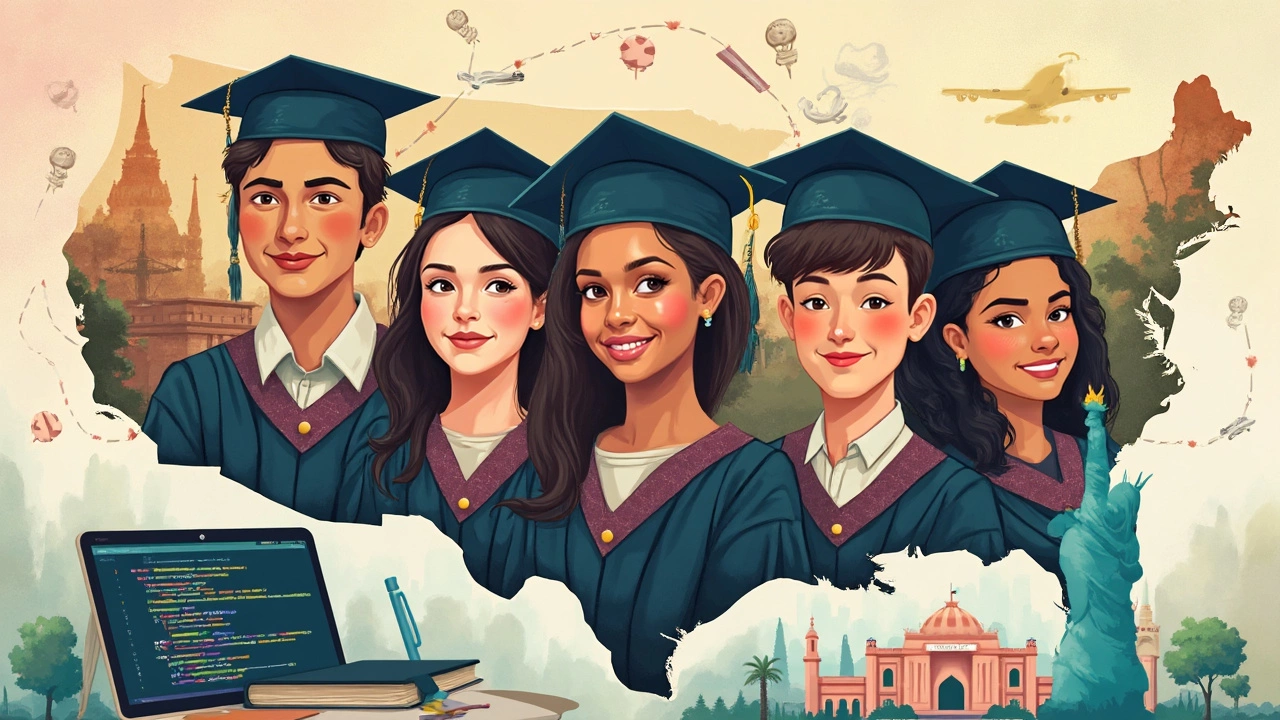You’ve probably heard the old joke—if you throw a stone in Silicon Valley, you’re likely to hit an IITian. It’s funny because, well, it’s kind of true. Indian Institute of Technology (IIT) alumni are everywhere in the US tech scene and beyond, and they’re not just filling seats—they’re calling the shots.
Cracking the IIT JEE isn’t just about flexing your math skills. It’s the first step into a network and a mindset that can take you half a world away. If you’re prepping for IIT JEE right now, it’s worth knowing where this journey can lead. Look at Sundar Pichai at Google or Arvind Krishna at IBM—these guys started out grinding for the same brutal exam as everyone else.
Knowing about their stories isn’t just cool trivia for your next group study session. It gives you a real-world idea of what’s possible and how past IITians shaped their own luck overseas. More than just brains, it’s their drive and adaptability that gets them noticed. And yes—they all started with the same late-night Problem Set headaches and ‘will I ever get in?’ moments.
- What Makes IITians Stand Out in the US
- Meet the Game-Changers: Top IITians Who Made Waves
- How Their IIT JEE Journey Set the Stage
- Tips for Aspiring IITians: Lessons from the Legends
What Makes IITians Stand Out in the US
People who crack the IIT JEE and make it to the Indian Institutes of Technology get more than a fancy degree. They’re trained to think fast, solve tough problems, and stick it out under insane pressure. This skillset doesn’t just help at college—it sets up IITians to thrive in high-stakes places like Silicon Valley or Wall Street.
Here's a crazy stat: According to a 2023 report by NASSCOM, over 50 CEOs or top executives of major US tech companies studied at IITs. That's a bigger number than any other single university in Asia. The IIT tag doesn't automatically make you successful, but it does get hiring managers and investors in the US to pay attention.
The secret sauce? It’s a mix of deep problem-solving skills, strong work ethic, and the ability to keep learning new stuff. Most of these guys didn’t just rest after landing a tech job—they took risks, tried out new ideas, and weren’t scared to mess up or start over.
“Graduates from IIT have a reputation for technical brilliance and creative problem-solving. It’s not just the curriculum; it’s the culture,” — Time Magazine, "The New Brains of Silicon Valley," 2018
- Solid network: IITians look out for each other. This alumni network opens doors, whether you’re job hunting or want help on a startup.
- Hunger to learn: Surviving those long nights prepping for IIT JEE means almost no deadline scares you later.
- Global mindset: Studying in India, then working in the US, gives IITians a unique perspective—making them quick to adapt in cross-cultural teams.
Check out how IITians stack up in the data:
| Category | US Grads (Top 10 Unis Avg) | IITians |
|---|---|---|
| US Tech CEOs (2023) | 33% | 42% |
| Average Years to Leadership Role | 9.5 | 8 |
| Patents Filed (per capita) | 1.7 | 2.3 |
The bottom line? Famous IITians in the US stand out because of grit, a killer network, and the habit of pushing for more, even when the odds are stacked high.
Meet the Game-Changers: Top IITians Who Made Waves
Let’s get straight to the big names—people who once crammed for the IIT JEE and now shape entire industries in the US. These famous IITians aren’t only headlines; they’ve changed what’s possible for students who follow the same path.
- Sundar Pichai (IIT Kharagpur, Metallurgical Engineering, 1993): Now the CEO of Google and Alphabet, he grew up in Chennai. After IIT, he earned an M.S. from Stanford and an MBA from Wharton. He helped launch the Chrome browser and rose through the ranks thanks to his sharp product sense and clear thinking.
- Arvind Krishna (IIT Kanpur, Electrical Engineering, 1985): The current CEO and Chairman of IBM since 2020. His journey through IBM’s research and cloud divisions proved you don’t need to be a founder to have massive influence.
- Parag Agrawal (IIT Bombay, Computer Science and Engineering, 2005): The former CEO of Twitter. Before leading Twitter, he was known for smart technical decisions behind the scenes.
- Rajeev Suri (IIT Delhi, Electronics and Communication Engineering, 1989): He led Nokia as CEO and now heads Inmarsat. Suri handled Nokia’s huge shift from phones to network equipment, showing how flexible IITians can be.
- Rakesh Gangwal (IIT Kanpur, 1975): Co-founder of IndiGo airlines and former CEO of US Airways, he’s a big name in both the aviation and business worlds.
Here’s a quick look at how their careers took off after IIT:
| Name | IIT/Year | Key Roles in the US | Notable Milestones |
|---|---|---|---|
| Sundar Pichai | Kharagpur/1993 | CEO, Google and Alphabet | Launched Chrome, took over as CEO in 2015 |
| Arvind Krishna | Kanpur/1985 | CEO and Chairman, IBM | Became CEO in 2020; led IBM’s cloud strategy |
| Parag Agrawal | Bombay/2005 | CEO, Twitter | Became CEO in 2021; focused on technical innovation |
| Rajeev Suri | Delhi/1989 | CEO, Nokia & Inmarsat | Transformed Nokia post-mobile phones |
| Rakesh Gangwal | Kanpur/1975 | Ex-CEO, US Airways; Co-founder, IndiGo | Major success in US and Indian airline sector |
See the pattern? Rocking the Famous IITians path isn’t only about tech. These guys moved between industries and roles, from building browsers to leading airlines. Having an IIT tag didn’t guarantee them a seat at the table—they hustled, took risks, and kept learning long after the JEE. If you’re looking for role models who’ve actually walked the talk, their stories are proof it’s possible to start in an IIT classroom and lead global companies.

How Their IIT JEE Journey Set the Stage
For every Famous IITians success story in the US, it all begins at one place: cracking the IIT JEE. This isn’t just any exam. It’s regarded as one of the toughest entrance tests in the world, taken by over a million hopefuls each year for just a few thousand spots. The process is punishing—long hours, years of study, even giving up on usual high school fun. If anyone tells you they breezed through, they're probably fibbing. Even Sundar Pichai, who cleared IIT JEE in 1989, called it a ‘life-shaping grind.’
But why does this struggle matter later? It’s about more than equations. Tackling the exam teaches you time management, staying cool under insane stress, pushing through frustration, and—big surprise—learning to fail and try again. Grit and problem-solving are baked into the IIT JEE experience. These become survival tools when you step outside India and into the deep end in the US, where the competition is on a whole different scale and nobody’s handing out free rides.
Here’s something you might not know: a lot of IITians end up at top US grad schools, not just because they’re smart, but because US admissions officers recognize the IIT JEE as a serious test of brains and resilience. Many famous names made their next jump—like Satya Nadella and Sundar Pichai—by first getting into US colleges for master’s degrees, using their IIT BTech degrees as a golden ticket.
The other thing is, the exam isn’t just about theory. If you’re prepping for IIT JEE, you’re learning how to attack real-world problems by breaking big headaches into small, manageable chunks. That kind of thinking is exactly what powers innovation when these alumni land in US jobs or startups. When Rajat Gupta became the first Indian-born Managing Director of McKinsey, or when Vinod Khosla built billion-dollar startups, the ‘solve it, don’t panic’ approach kicked in—an approach that started with all those years hunched over IIT JEE practice papers.
So, if you’re grinding through physics or stuck on a tricky calculus problem, remember: past IITians used the same skills and mindset to push through way bigger roadblocks in the US. It’s less about perfect scores and more about the attitude you pick up along the way. That’s what ends up setting you apart in the crowded world out there.
Tips for Aspiring IITians: Lessons from the Legends
Every famous IITian in the US, whether it’s Sundar Pichai or Parag Agrawal, built their story on daily habits, sharp priorities, and quick course correction. If you're hustling to join their club, it helps to unpack what worked for them—because luck alone didn’t get them where they are.
Take Sundar Pichai. He openly talked about humble beginnings—he didn’t even have a phone at home growing up, but he always stayed hungry to learn and adapt. When he moved to the US for Stanford, he doubled down on reading, learning, and jumping at every chance to build new skills. Adaptability and deep focus mattered as much as raw talent.
- Famous IITians know how to juggle focus with flexibility. If something isn’t working, they quickly pivot. Arvind Krishna, now CEO of IBM, switched research fields several times at IIT Kanpur to follow what sparked his interest most.
- Collaboration isn’t just a buzzword. N. R. Narayana Murthy, co-founder of Infosys, often credits group projects and hostel discussions at IIT Kanpur for helping him think on his feet and see things from new angles.
- Don’t ignore soft skills. For example, Rajeev Motwani, the IIT Kanpur grad who mentored Larry Page and Sergey Brin at Stanford, was known for his open-door policy and friendly approach—skills just as vital as any math trick.
Here’s some real talk—95% of current IITians say they relied more on strategic study rather than long hours, according to an internal student survey in 2023. Past graduates agree: smart revision and practice tests—over brute-force cramming—win the race.
| IITian | US Milestone Role | Key IIT Habit |
|---|---|---|
| Sundar Pichai | Google CEO | Keen problem solving, adaptability |
| Arvind Krishna | IBM CEO | Following curiosity, pivoting when stuck |
| Rajeev Motwani | Stanford Professor, Google mentor | Mentorship, open collaboration |
| Manoj Bhargava | Founder, 5-hour Energy | Thinking differently, entrepreneurial spirit |
If you’re serious about following these legends, here are some things to try right now:
- Set a short, clear study target for each day. Don’t overwhelm yourself with ten-hour marathons that just burn you out.
- Find a study buddy or group. Honest peer feedback works better than silent grinding.
- Mix things up. If old methods stall you, experiment—maybe active recall or teaching a topic out loud will boost your game.
- Stay open to feedback, not just from teachers but from anyone who’ll spend five minutes listening.
- Look at mistakes as tools, not proof you’re failing. Most top IITians bombed plenty of mock tests before they cracked the main exam.
Big dreams in the US often start with small actions at home. Start by following the habits that worked for the people you look up to. It’s not about being superhuman—it’s about consistency and learning from every stumble.
